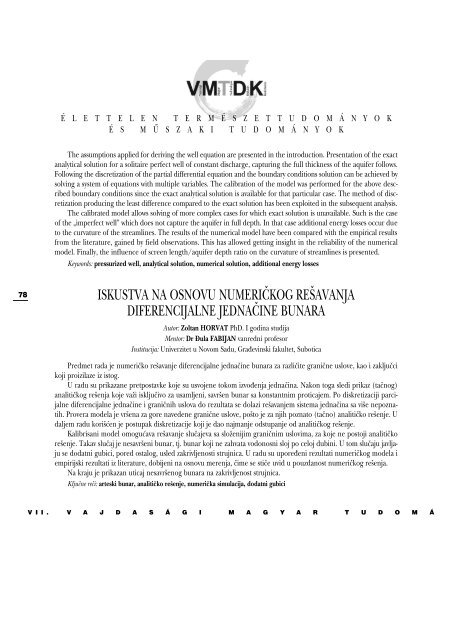Rezümékötet 2008. - vmtdk
Rezümékötet 2008. - vmtdk
Rezümékötet 2008. - vmtdk
You also want an ePaper? Increase the reach of your titles
YUMPU automatically turns print PDFs into web optimized ePapers that Google loves.
78<br />
É L E T T E L E N T E R M É S Z E T T U D O M Á N Y O K<br />
É S M Û S Z A K I T U D O M Á N Y O K<br />
The assumptions applied for deriving the well equation are presented in the introduction. Presentation of the exact<br />
analytical solution for a solitaire perfect well of constant discharge, capturing the full thickness of the aquifer follows.<br />
Following the discretization of the partial differential equation and the boundary conditions solution can be achieved by<br />
solving a system of equations with multiple variables. The calibration of the model was performed for the above described<br />
boundary conditions since the exact analytical solution is available for that particular case. The method of discretization<br />
producing the least difference compared to the exact solution has been exploited in the subsequent analysis.<br />
The calibrated model allows solving of more complex cases for which exact solution is unavailable. Such is the case<br />
of the „imperfect well” which does not capture the aquifer in full depth. In that case additional energy losses occur due<br />
to the curvature of the streamlines. The results of the numerical model have been compared with the empirical results<br />
from the literature, gained by field observations. This has allowed getting insight in the reliability of the numerical<br />
model. Finally, the influence of screen length/aquifer depth ratio on the curvature of streamlines is presented.<br />
Keywords: pressurized well, analytical solution, numerical solution, additional energy losses<br />
ISKUSTVA NA OSNOVU NUMERIÈKOG REŠAVANJA<br />
DIFERENCIJALNE JEDNAÈINE BUNARA<br />
Autor: Zoltan HORVAT PhD. I godina studija<br />
Mentor: Dr Ðula FABIJAN vanredni profesor<br />
Institucija: Univerzitet u Novom Sadu, Graðevinski fakultet, Subotica<br />
Predmet rada je numerièko rešavanje diferencijalne jednaèine bunara za razlièite graniène uslove, kao i zakljuèci<br />
koji proizilaze iz istog.<br />
U radu su prikazane pretpostavke koje su usvojene tokom izvoðenja jednaèina. Nakon toga sledi prikaz (taènog)<br />
analitièkog rešenja koje važi iskljuèivo za usamljeni, savršen bunar sa konstantnim proticajem. Po diskretizaciji parcijalne<br />
diferencijalne jednaèine i graniènih uslova do rezultata se dolazi rešavanjem sistema jednaèina sa više nepoznatih.<br />
Provera modela je vršena za gore navedene graniène uslove, pošto je za njih poznato (taèno) analitièko rešenje. U<br />
daljem radu korišæen je postupak diskretizacije koji je dao najmanje odstupanje od analitièkog rešenje.<br />
Kalibrisani model omoguæava rešavanje sluèajeva sa složenijim graniènim uslovima, za koje ne postoji analitièko<br />
rešenje. Takav sluèaj je nesavršeni bunar, tj. bunar koji ne zahvata vodonosni sloj po celoj dubini. U tom sluèaju javljaju<br />
se dodatni gubici, pored ostalog, usled zakrivljenosti strujnica. U radu su uporeðeni rezultati numerièkog modela i<br />
empirijski rezultati iz literature, dobijeni na osnovu merenja, èime se stièe uvid u pouzdanost numerièkog rešenja.<br />
Na kraju je prikazan uticaj nesavršenog bunara na zakrivljenost strujnica.<br />
Kljuène reèi: arteski bunar, analitièko rešenje, numerièka simulacija, dodatni gubici<br />
V I I . V A J D A S Á G I M A G Y A R T U D O M Á




